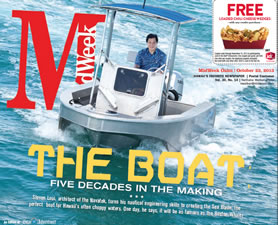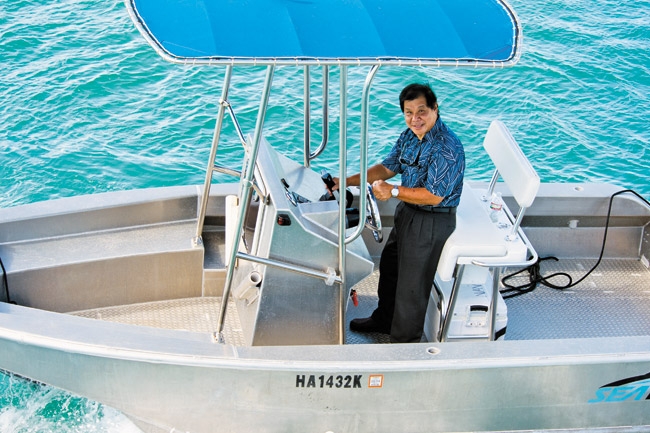The Boat: Five Decades In The Making
Steven Loui, architect of the Navatek, turns his nautical engineering skills to creating the Sea Blade, the perfect boat for Hawaii’s often choppy waters. One day, he says, it will be as famous as the Boston Whaler
Steven Loui, architect of the Navatek, turns his nautical engineering skills to creating the Sea Blade, the perfect boat for Hawaii’s often choppy waters Growing up with a father who is a visionary can be a challenge, unless you’re a visionary yourself.
mw-cover-102313-coralandrews-1
Steven Loui always has been a man of action, someone driven to make his dreams a reality. Thinking was never enough. Loui is a doer. It’s a trait that was instilled in him early in life and one that was nurtured while growing up at the boat docks, watching his father, Fred Loui, work on his craft.
“My father built the first fiberglass boats in Hawaii between 1958 and 1962, so when I was a kid, 7 or 8 years old, this was the most fun stuff going on,” laughs Loui. “I helped fiberglass these boats and then we used to go water skiing on them.”
Loui smiles when he reminisces about family outings on the boats his father designed.
There was something special about the ocean that touched his heart. He was at home on the sea. And even as a young child attending Liholiho Elementary School in Kaimuki, Loui knew he had a gift. He recognized that there was something more that could be done to improve the riding experience for small powerboat owners and their passengers.
“For the late 1950s and early 1960s it was not a bad design, but in the scheme of things it was a horrible-riding boat,” chuckles Loui. “They pounded the heck out of you. Basically, at 8 years old I learned about small-boat building. I said there’s got to be a way to design a better-riding boat.”
He knew just the person who could make it better. What he didn’t know was it would take him more than five decades to realize his dream.
The beginning of a legacy
Fred Loui literally built his company from the ground up. In 1944, he started Pacific Marine & Supply with a simple business philosophy: Buy local. He believed it was important to have locally built boats rather than rely on importing them from elsewhere.
The Deep-V Hull form was introduced in 1958 and is still the most common hull form for rough seas. But the hull had limitations, especially in ocean conditions that exceeded 4 feet. Common problems included rolling, heeling, plunging and the dreaded pounding and slamming.
Steven Loui attended Kaimuki High School, where his desire to produce the ideal boat intensified. Time on the ocean confirmed his life’s path.
“Throughout my teenage years and high schools years, we used to go boating, and that’s what got my interest up,” he says. “I got the chance to try all types of different boats, and most of the boats were not good riding boats. I have a lot of permanent dings in my shin to prove it! Who better to design boats for Hawaii than people from Hawaii?”
Loui would go on to attend Stanford University where he earned an engineering degree. But home is where he wanted to be. He had unfinished work to address.
Motivated to make a difference
We are all motivated by different reasons. Pioneers and mentors inspire some, while others yearn for fame and stardom. But for the Stanford graduate, his motivation became more focused after noticing a large number of injuries to powerboat riders when operating in rough seas. Loui saw a need to improve the safety, quality and efficiency of vessels, while pushing the limits of marine technology.
In 1990, he designed the innovative double-hulled, 141-foot SWATH vessel, Navatek I. The hulls on Navatek I would ride below the water, which would improve the ride quality and decrease the incidences of seasickness from 10 percent of passengers to less than 1/2 percent. Loui then attached a luxurious superstructure and created the first dinner cruise that could operate on Oahu’s Gold Coast from Honolulu to Koko Head. In 1992, the operation grossed more than $11 million in sales and allowed Navatek to grow to one of Hawaii’s premier high technology companies.
Then, in 2005, he launched his latest project. His goal was to re-engineer rough sea hull design that some say had not seen changes or improvements since its invention more than 50 years ago.
“We have this cultural legacy of being a seafaring people, but you can’t say that about modern Hawaii,” says Loui. “Most of the boats here in Hawaii, after people buy them, they sit in a garage. Hawaii has one of the lowest boat ownerships per capita, and you keep on asking why. It’s because our seas are consistently rough. You go out and you get blasted even though it’s so pretty.”
Sea Blade is born
After seven years, numerous military vessel prototypes, 28 patents and inventions and countless hours in Hawaiian waters, Sea Blade was born. Many are already calling it the ideal boat for Hawaii’s watermen.
“Most boats that are light, they don’t ride very well, and if they’re heavy they get sluggish,” explains Loui. “It took more than 52 years of learning and a few years ago it all came together. Our prototype worked and we said that’s it!”
Sea Blade is the first multi-application product line for Navatek Boat Builders, a newly formed subsidiary of Navatek. The homegrown company prides itself on being a sustainable, boatbuilding enterprise that utilizes local resources to build recreational, government and commercial high-performing boats for Hawaii’s rough ocean conditions. The vessel will be manufactured in Hawaii and sold locally and on the U.S. mainland.
“We finally got a prototype that I felt reached what I was looking for, and it took 52 years,” says Loui with a huge grin. “I went all over the world and found unusual non-conventional hull forms because this was my quest to get a good rough-riding boat for Hawaii.”
It was during his world travels when Loui realized that most waters were not as consistently rough as Hawaii’s, so boat builders didn’t have the drive to make a good riding boat. Hawaii’s wide range of ocean conditions and its warm climate made it ideal for ship and boat research.
Besides better comfort and better efficiencies in rough seas, Loui wanted to design a hull that ultimately provided less fatigue on the driver and passengers.
“I’ve had a range of experiences, I’ve tried different boats, met many designers and I spent a whole lot of time in the water riding these boats,” says Loui. “There is a little bit of a lot of these experiences. I had tools available to me that most designers don’t have.”
Sea Blade features Ultra High Deadrise (UHD) panels and longitudinal steps. Loui says the design makes for soft re-entry landings, and reduces slamming, pounding and plunging in ocean conditions greater than 4 feet. The hull design also includes Entrapment Tunnel (ETM) Technology and features a pair of amas (outriggers) that trap air and water for efficient lift.
“It’s like training wheels on a bike,” explains Loui. “These refined amas stabilize the boat and give you good directional stability as well.”
A smooth ride
Loui brought MidWeek out on the ocean for a test run on the 19-foot aluminum Sea Blade and purposely accelerated into large swells. He was searching for launching pads, while we braced for impact. The knee-buckling jolts so often felt on smaller powerboats never happened.
“As you come crashing down, the pressure is hitting all sides of the hull until it reaches maximum pressure. That’s the spike – that’s what slams you, that’s what knocks you off your feet and takes your knees out,” he says. “You’re not going to find a better-riding boat.”
Experienced boaters immediately can feel the difference.
“You’re not coming down on the V, you’re punching through the water and actually slapping the water, so you dampen the blow immediately and it slows your velocity. Even the untrained eye can see that,” says Loui. “It’s about safety. One of the things that was really important to me was that a novice could jump on this boat and they can’t get into trouble.”
The Navatek quickly is filling out its initial model line of 16-, 19-, 22- and 24-foot hulls. The semi-custom boats give the customer the option of being built from fiberglass or tougher aluminum and tailor-made to whatever purpose or level of finish desired. Prices will range from $30,000 to $150,000. The 30-foot hulls will be custom built, primarily for military or commercial use. Loui says the Sea Blade may not be for everyone, but the market needs something like it.
“One day the Sea Blade will be as famous as the Boston Whaler,” he says with confidence. “It’s still the aspirational boat for many people. It wasn’t worth the effort if I couldn’t be better than a 19-foot Whaler. If we can take over the market position of being the best rough-water boat around the world, maybe we’ll sell a lot.”
Leave his own legacy
Fred Loui died at the age of 51. After graduating from Stanford in 1972, Steven took over the business in 1973 and built it into one of Hawaii’s strongest marine companies. Since then, sales have grown from $3 million annually to more than $56 million annually.
“My father wanted to build a big dry dock and although he was young enough and he had the financial capacity, he died before he could see it come true,” says Loui. “Now we have the state’s biggest private docks. I’ve been inspired by his dreams, and some of them have become my dreams. He was just a creative guy and a visionary. It’s like I’m helping him to realize his dreams.”
Steven Loui’s primary goal now is to inspire the next generation of young engineers.
“I’ve been running the company for 41 years, although some people wish I would retire,” he laughs. “I’m the product of a long heritage in boat design and the maritime tradition, and now that I’m 62, I want to see it carried on. All of our young engineers are in their 20s and 30s and, for me, it’s exciting to know they’re going to make it better. We all share a passion for a profession with a long legacy from Hawaii. This is not about making millions, this is about providing jobs and providing for the future.”
It’s what visionaries do. Steven Loui should know.







